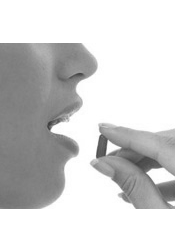pdp-Isoniazid tablets
This product is manufactured by Pendopharm using the ingredient isoniazid.
This product is taken orally.

play
orally
Why is it prescribed?
Isoniazid is used in combination with other antituberculosis drugs to treat tuberculosis. It is also used alone to prevent tuberculosis.
It is very important to take pdp-Isoniazid exactly as directed by your doctor. Never stop taking the medication without permission from your doctor. Store at room temperature, away from heat and moisture.
If you miss a dose of this medicine, take it as soon as possible. However, if it is almost time for your next dose, skip the missed dose and go back to your regular dosing schedule. Do not double doses (unless you have been instructed to do so).
pdp-Isoniazid is best absorbed if taken on an empty stomach (1 hour before meals or 2 hours after), but may be taken with food if stomach upset occurs. Take with a full glass of water.
If taken with certain foods such as cheese (Swiss or Cheshire) or fish (e.g. tuna, skipjack), it may cause redness or itching of the skin, hot feeling, fast or pounding heartbeat, sweating, chills or clammy feeling, headache, or lightheadedness.
Alcohol consumption should be at a minimum to reduce the possibility of liver problems.
Notify your doctor if you experience any of the following: yellowing of the skin or eyes, darkening of the urine, appetite loss, nausea, vomiting, numbness or tingling of hands or feet, fatigue.
Your doctor may want you to undergo periodic eye exams even if you are not experiencing any visual problems.
Alternatives
Other products that have the same ingredient as pdp-Isoniazid tablets are •pdp-Isoniazid solution •
See other products used in the treatment of •tuberculosis •
Active tuberculosis (in combination with other antitubercular agents): Adults: 5 mg for each kilogram of body weight once daily (maximum 300 mg); children: 10 to 20 mg for each kilogram of body weight once daily (maximum 300 mg). Treatment will last for 6 to 9 months or longer. Following 2 months of once a day dosing, you will switch to intermittent dosing (i.e. 2 or 3 times weekly) Adults: 15 mg for each kilogram of body weight (maximum 900 mg per dose); children: 20 to 40 mg for each kilogram of body weight (maximum 900 mg per dose).
Prevention of tuberculosis: Adults: 300 mg once daily; Children: 10 mg for each kilogram of body weight once daily (maximum 300 mg). Preventive therapy is usually given for a period of 6 to 12 months.
Isoniazid is an antituberculosis drug that kills bacteria that causes tuberculosis. It inhibits bacterial cell wall synthesis.
Along with its needed effects, isoniazid may cause some unwanted or undesirable effects. People who are more likely to experience some of these effects will usually possess one or more of the following risk factor: old age, alcoholism, liver or kidney disease, seizure disorders.
Possible unwanted effects include:
- abnormal liver function tests
- nausea
- vomiting
- diarrhea
- stomach ache
- rash
- dizziness
- drowsiness
- jaundice (yellowing of the skin or eyes)
- itching
- vitamin B6 deficiency
- pain or tingling in hands or feet
Uncommon:
- increased blood sugar
- vision problems
- breast enlargement
If you suspect you are experiencing any unwanted effects, report them to your doctor or pharmacist.
An allergic reaction sometimes occurs with isoniazid (usually occurs within the first 3 to 7 weeks of therapy). Symptoms may include fever, rash, hives, swollen lymph nodes, itching and difficult breathing. Notify your doctor if any of theses symptoms occur.
Vitamin B6 (pyridoxine) deficiency can occur during treatment and your doctor may instruct you to take a supplement.
Isoniazid may cause liver problems. Immediately report symptoms of liver problems such as fatigue, weakness, nausea or vomiting, dark urine or yellowing of the skin.
Certain foods such as cheese (e.g. Swiss or Cheshire) or fish (e.g. tuna, skipjack) may cause redness or itching of the skin, hot feeling, fast or pounding heartbeat, sweating, chills or clammy feeling, headache, or lightheadedness.
You should also strictly limit the amount of alcoholic beverages while on isoniazid. Alcohol may keep this medicine from working properly and may be more likely to cause liver problems.
Drug interactions: It is important to tell your doctor and pharmacist about any prescription or over-the-counter medications you are taking to help avoid any serious drug interactions. The dose of one or both medications may need to be altered or a new drug may be prescribed. In some cases, one of the drugs may have to be discontinued. The following is a list of drugs and drug classes that have been known to interact with isoniazid.
- alcohol
- aluminum salts (e.g. antacids) - take isoniazid 1 hour before antacids
- acetaminophen (e.g. Tylenol®)
- blood thinners (e.g. warfarin)
- carbamazepine (e.g. Tegretol®)
- benzodiazepines (e.g. diazepam)
- seizure medication (e.g. phenytoin)
- rifampin
- ketoconazole (e.g. Nizoral®)
- meperidine (e.g. Demerol®)
Use is not recommended in the following situations:
- allergy to isoniazid or any component of the preparation
Caution is recommended in the following situations:
- kidney or liver disease
Use in pregnancy: Isoniazid is the drug of choice for treatment of tuberculosis in pregnancy. Liver function tests throughout the pregnancy are recommended. Consult your doctor or pharmacist if you suspect you are pregnant.
Use while breastfeeding: Isoniazid is passed into breast milk. No adverse effects have been reported, but there is a potential risk of nerve or liver damage. Breast-fed infants should be carefully observed for these effects. Contact your doctor or pharmacist before use.
